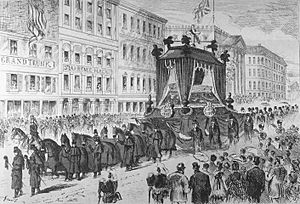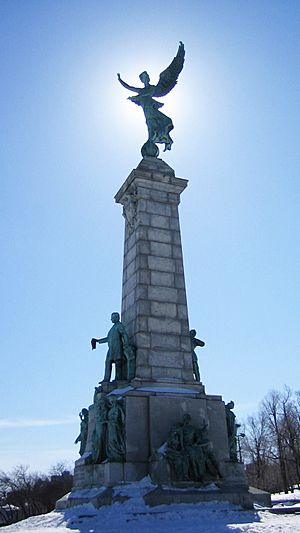George-Étienne Cartier facts for kids
Quick facts for kids
Sir George-Étienne Cartier
Bt, PC
|
|
|---|---|
 |
|
| Premier of Canada East | |
| In office August 6, 1858 – May 24, 1862 |
|
| Monarch | Victoria |
| Governor-General | Edmund Walker Head The Viscount Monck |
| Joint Premier | John A. Macdonald |
| Preceded by | Étienne-Paschal Taché |
| Succeeded by | Étienne-Paschal Taché |
| Minister of Militia and Defence | |
| In office July 1, 1867 – May 20, 1873 |
|
| Prime Minister | John A. Macdonald |
| Preceded by | John A. Macdonald |
| Succeeded by | Hugh McDonald |
| Personal details | |
| Born | September 6, 1814 Saint-Antoine-sur-Richelieu, Lower Canada |
| Died | May 20, 1873 (aged 58) London, England |
| Resting place | Notre Dame des Neiges Cemetery, Montreal |
| Political party | Conservative Party of Canada, (pre-confederation) Parti Bleu Patriote |
| Spouse | Hortense Fabre |
| Profession | Lawyer |
| Signature | |
| Military service | |
| Allegiance | Parti patriote Republic of Lower Canada |
| Branch/service | Société des Fils de la Liberté |
| Years of service | 1837–1838 |
| Battles/wars | Lower Canada Rebellion
|
Sir George-Étienne Cartier (born September 6, 1814, died May 20, 1873) was an important Canadian leader. He is known as one of the Fathers of Confederation, who helped create Canada as a country. His name was spelled George, not Georges (the usual French way), because he was named after King George III.
Before Canada became a country, Cartier was a very important politician in Canada East (now Quebec). He led a political group called the Parti bleu. In 1838, he came back to Montreal after being away for a year. He had been exiled because of his part in the Lower Canada Rebellion. Cartier officially started his political career in 1848.
During his long career, he worked to make the Civil Code the main law in Canada East. This was different from the common law used in Canada West. He also helped bring in primary education (elementary school) in the province. Cartier supported Confederation for several reasons. One big reason was his worry about American expansion into Canadian lands. He passed away in London, England, on May 20, 1873.
Contents
Early Life and Career Beginnings
George-Étienne Cartier was born on September 6, 1814. His birthplace was Saint-Antoine-sur-Richelieu, which was then called Lower Canada. Cartier went to school and became a lawyer in 1834. He started his own law practice. He also worked with railway companies, and the Grand Trunk Railway was one of his clients.
Early in his career, Cartier was inspired by a leader named Louis-Joseph Papineau. Because of this connection, Cartier joined a group called the Société des Fils de la Liberté ("Sons of Liberty"). He took part in the Lower Canada Rebellion of 1837, fighting in the Battle of Saint-Denis. Because of his role in the rebellion, Cartier had to leave the country. He found safety for a short time in Vermont, USA. However, he was allowed to return to Montreal in 1838 and continue his law work.
Entering Politics and the Great Coalition
When Cartier returned to Lower Canada in 1838, it was now called Canada East within the Province of Canada. He continued his law practice. He was also a member of the Saint-Jean-Baptiste Society. He became active in politics by helping Louis-Hippolyte Lafontaine with his election campaigns. In 1848, Cartier stopped practicing law and ran for office himself. He was elected to the Legislative Assembly of the Province of Canada as a Reformer.
While in the Union parliament, Cartier introduced a bill in 1852. This bill led to the creation of the Grand Trunk Railway Company of Canada. In 1854, Cartier was chosen to be part of the cabinet. From 1857 to 1862, he served as co-premier of the united province alongside John A. Macdonald. Cartier was a very loyal friend to Macdonald. Together, they formed the Great Coalition with George Brown in 1864. The main goal of the Great Coalition was to stop the political problems in the province. Before this, there had been six different governments in six years.
The Great Coalition was a big step towards Confederation. Cartier attended all three important meetings held for this purpose: the Charlottetown, Quebec, and London conferences. Cartier was very important in getting French-Canadian support for the idea of a united Canada.
Cartier also played a key role in making new laws. These laws ended the old seigneurial system of land ownership in Lower Canada. He also helped change the legislative council into a group of elected representatives. He successfully pushed for the Civil Code to be used in the province.
Political Life in the Dominion of Canada
When the Dominion of Canada was created in 1867, John A. Macdonald became the first Prime Minister. Cartier was chosen as his Minister of Militia and Defence. At that time, a person could hold positions in both the federal and provincial governments. So, Cartier also ran in the 1867 Quebec provincial election. He was elected in the Montréal-Est area as a Conservative supporter. This meant Cartier was a member of both the Parliament of Canada and the Legislative Assembly of Quebec.
In the federal government, Cartier represented Montreal East after Canada's first election in 1867. In the next federal election in 1872, he lost his seat in Montreal East. However, the next month, Cartier was elected without opposition in the Manitoba area of Provencher. This happened after Louis Riel and Henry James Clarke stepped down as candidates there.
Cartier had planned to support a pardon for Riel. Riel had set up a temporary government in the Northwest. Cartier was related to Riel through their family history. Both were descendants of Zacharie Cloutier, an early Canadian pioneer.
During his time in Ottawa, Cartier was in charge of talks with Britain and the Hudson's Bay Company. These talks were about Canada buying Rupert's Land and the North-Western Territory. Cartier also helped with the talks that led to the creation of Manitoba province. He also helped British Columbia join Confederation. Staying true to his railway connections, Cartier introduced a bill in 1872 to create the Canadian Pacific Railway. From 1867 to 1873, he was the Minister of Militia and Defence.
Illness and Death

In 1871, Cartier started showing signs of a kidney disease. After the 1872 election, Cartier went to London, hoping to get better. But his health did not improve. He died in London on May 20, 1873, at 58 years old. He was never able to visit his riding in Manitoba where he had been elected. His body was brought back to Canada. He was buried in the Cimetière Notre-Dame-des-Neiges in Montreal, after a public funeral.
Family Life
George-Étienne Cartier married Hortense Fabre on June 16, 1846. Hortense was the daughter of Édouard-Raymond Fabre, who used to be the mayor of Montreal. They had three daughters, but one died when she was a baby. Another daughter passed away in 1886. After Cartier died, his wife, Lady Cartier, received a pension of $1,200. This was to recognize her husband's important work. When their eldest daughter, Caroline, died in March 1886, her wish was to be buried next to her father in Montreal. Lady Cartier and their last surviving daughter, Hortense, lived in Cannes, France. Lady Cartier died on February 27, 1898. She was buried in Quebec with her husband and daughter in Notre Dame des Neiges Cemetery. In 1892, Lady Cartier gave a marble statue of her husband to the Legislative Assembly of Quebec. Cartier's niece, Victoria Cartier, was a well-known Canadian music teacher, organist, and pianist.
Cartier's Legacy
Cartier's most important contribution to Canada was helping Canada East (Quebec) join Confederation. After the rebellions in 1837-1838 and the Durham Report, Upper and Lower Canada were joined into one colony. Great Britain was starting to loosen its control over its North American colonies. The United States was growing stronger and was seen as a threat to Canada.
In 1864, George Brown, a political leader from Canada West (Ontario), suggested an alliance. This alliance was with the Conservatives led by Macdonald and Cartier. In 1867, after many discussions and conferences (in Charlottetown and Quebec), this alliance, known as the Grand Coalition, succeeded. They created the agreement that led to Confederation. From that time on, the new federal government met in Ottawa. In 1834, Cartier also helped create the Société Saint-Jean-Baptiste, a patriotic group. There, he sang his famous poem, "Ô Canada, mon pays! mes amours!" (This is not the same as Canada's national anthem).
Honours and Memorials
To celebrate his important role in Canada's growth, Queen Victoria made Cartier a baronet of Montreal in 1868. A baronet is a special title of honour. Since he had no sons to inherit the title, the Cartier baronetcy ended when he died. He also received the title "The Honourable" and "PC" for life. This was because he became a member of the Queen's Privy Council for Canada on July 1, 1867.
Many places are named after Cartier and his fellow Father of Confederation, John A. Macdonald. These include:
- Ontario's Macdonald-Cartier Freeway (Hwy 401)
- Ottawa's Macdonald-Cartier International Airport
- The Macdonald-Cartier Bridge, which connects Ottawa, Ontario, with Gatineau, Quebec.
- The former Macdonald-Cartier High School in Saint-Hubert, Quebec, which is now part of Heritage Regional High School.
Cartier's home in Montreal, at 458 Notre-Dame Street East, is now the Sir George-Étienne Cartier National Historic Site. This site celebrates his life and achievements. It also shows what life was like for upper-middle-class families in 19th-century Montreal.
In 1931, Canada Post released a ten-cent postage stamp with Cartier's picture. It was surrounded by the maple leaf, Canada's national symbol.
Many streets in Quebec and other parts of Canada are named after Cartier. The Montreal Metro's Cartier station in Laval, Quebec is also named after him.
Six schools have been named in his honour:
- George-Étienne Cartier French Catholic primary school in Ottawa, Ontario.
- George-Étienne Cartier primary school in Gatineau, Québec.
- George-Étienne-Cartier French preschool in Longueuil, Quebec.
- Sir George-Étienne Cartier Primary school in London, Ontario.
- George-Étienne Cartier French Catholic primary school in Toronto, Ontario.
- École secondaire Macdonald-Cartier high school in Sudbury, Ontario.
He was played by David La Haye in the 2011 CBC Television movie John A.: Birth of a Country.
In 2017, the Bank of Canada released a special Canadian ten-dollar note to celebrate Canada 150. This banknote features Cartier's picture along with Sir John A. Macdonald, Agnes Macphail, and James Gladstone.
Images for kids
See also
 In Spanish: George-Étienne Cartier para niños
In Spanish: George-Étienne Cartier para niños




